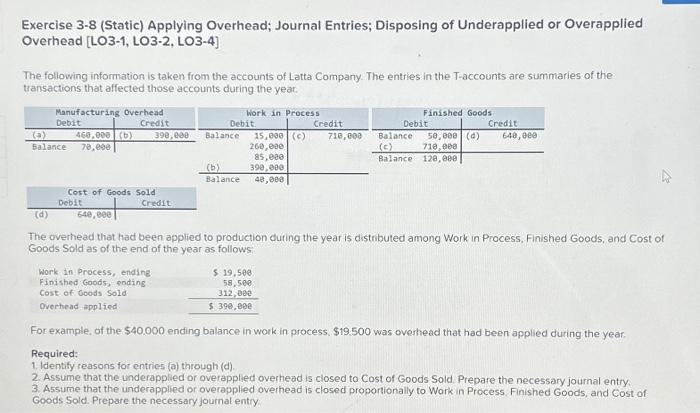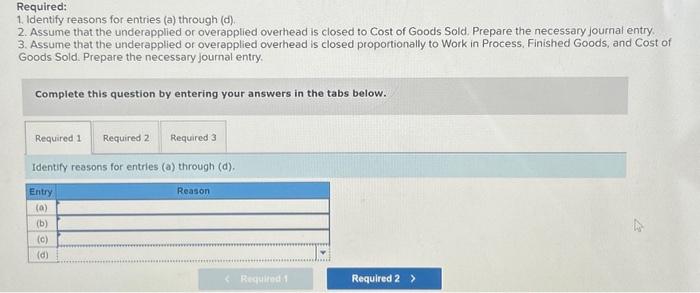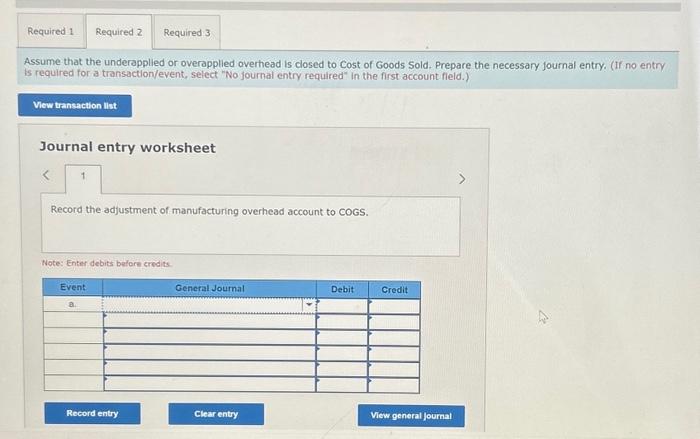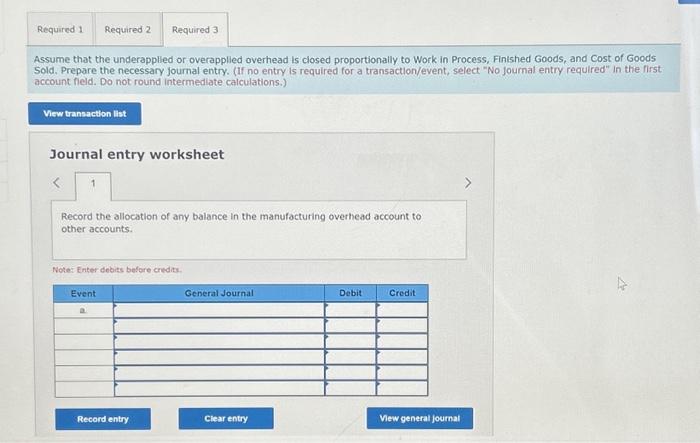Answered step by step
Verified Expert Solution
Question
1 Approved Answer
Exercise 3-8 (Static) Applying Overhead; Journal Entries; Disposing of Underapplied or Overapplied Overhead [LO3-1, LO3-2, LO3-4] The following information is taken from the accounts of
Exercise 3-8 (Static) Applying Overhead; Journal Entries; Disposing of Underapplied or Overapplied Overhead [LO3-1, LO3-2, LO3-4] The following information is taken from the accounts of Latta Company. The entries in the T-accounts are summaries of the transactions that affected those accounts during the year. Manufacturing Overhead Credit Debit (a) Balance 70,000 460,000 (b) Cost of Goods Sold Debit 640,000 Credit Work in Process Debit 390,000 Balance 15,000 (c) 710,000 260,000 85,000 390,000 40,000 (b) Balance Credit Finished Goods $ 19,500 58,500 312,000 $ 390,000 Debit Balance 50,000 (d) (c) 710,000 Balance 120,000 Credit (d) The overhead that had been applied to production during the year is distributed among Work in Process, Finished Goods, and Cost of Goods Sold as of the end of the year as follows: 640,000 Work in Process, ending Finished Goods, ending Cost of Goods Sold Overhead applied For example, of the $40,000 ending balance in work in process, $19,500 was overhead that had been applied during the year. Required: 1. Identify reasons for entries (a) through (d). 2. Assume that the underapplied or overapplied overhead is closed to Cost of Goods Sold. Prepare the necessary journal entry. 3. Assume that the underapplied overapplied overhead is closed proportionally to Work in Process, Finished Goods, and Cost of Goods Sold. Prepare the necessary journal entry. 


 Exercise 3-8 (Static) Applying Overhead; Journal Entries; Disposing of Underapplied or Overapplied Overhead [LO3-1, LO3-2, LO3-4] The following information is taken from the accounts of Latta Company. The entries in the T-accounts are summaries of the transactions that affected those accounts during the year: The overhead that had been applied to production duting the year is distributed among Work in Process, Finished Goods, and Cost of Goods Sold as of the end of the year as follows: For example, of the $40.000 ending balance in work in process. $19.500 was overhead that had been applied during the year. Required: 1. Identify reasons for entries (a) through (d). 2. Assume that the underapplied or overapplied overhead is closed to Cost of Goods Sold. Prepare the necessary journal entry 3. Assume that the underapplied or overapplied overhead is closed proportionally to Work in Process. Finished Goods, and Cost of Goods Sold. Prepare the necessary journal entry Required: 1. Identify reasons for entries (a) through (d). 2. Assume that the underapplied or overapplied overhead is closed to Cost of Goods Sold. Prepare the necessary journal entry 3. Assume that the underapplied or overapplied overhead is closed proportionally to Work in Process, Finished Goods, and Cost of Goods Sold. Prepare the necessary journal entry. Complete this question by entering your answers in the tabs below. Identify reasons for entries (a) through (d). Assume that the underapplied or overapplied overhead is closed to cost of Goods Sold. Prepare the necessary journal entry. (Ir no entry is required for a transaction/event, select "No journal entry required" in the first account field.) Journal entry worksheet Record the adjustment of manufacturing overhead account to coGS. Note: Enter debits belore sredits. Assume that the underapplied or overapplied overhead is closed proportionally to Work in Process, Finished Goods, and Cost of Goods Sold. Prepare the necessary journal entry. (If no entry is required for a transaction/event, select "No Journal entry required" in the first account field. Do not round intermedlate calculations.) Journal entry worksheet Record the allocation of any balance in the manufacturing overhead account to other accounts. Fotez Enker debits befere credits
Exercise 3-8 (Static) Applying Overhead; Journal Entries; Disposing of Underapplied or Overapplied Overhead [LO3-1, LO3-2, LO3-4] The following information is taken from the accounts of Latta Company. The entries in the T-accounts are summaries of the transactions that affected those accounts during the year: The overhead that had been applied to production duting the year is distributed among Work in Process, Finished Goods, and Cost of Goods Sold as of the end of the year as follows: For example, of the $40.000 ending balance in work in process. $19.500 was overhead that had been applied during the year. Required: 1. Identify reasons for entries (a) through (d). 2. Assume that the underapplied or overapplied overhead is closed to Cost of Goods Sold. Prepare the necessary journal entry 3. Assume that the underapplied or overapplied overhead is closed proportionally to Work in Process. Finished Goods, and Cost of Goods Sold. Prepare the necessary journal entry Required: 1. Identify reasons for entries (a) through (d). 2. Assume that the underapplied or overapplied overhead is closed to Cost of Goods Sold. Prepare the necessary journal entry 3. Assume that the underapplied or overapplied overhead is closed proportionally to Work in Process, Finished Goods, and Cost of Goods Sold. Prepare the necessary journal entry. Complete this question by entering your answers in the tabs below. Identify reasons for entries (a) through (d). Assume that the underapplied or overapplied overhead is closed to cost of Goods Sold. Prepare the necessary journal entry. (Ir no entry is required for a transaction/event, select "No journal entry required" in the first account field.) Journal entry worksheet Record the adjustment of manufacturing overhead account to coGS. Note: Enter debits belore sredits. Assume that the underapplied or overapplied overhead is closed proportionally to Work in Process, Finished Goods, and Cost of Goods Sold. Prepare the necessary journal entry. (If no entry is required for a transaction/event, select "No Journal entry required" in the first account field. Do not round intermedlate calculations.) Journal entry worksheet Record the allocation of any balance in the manufacturing overhead account to other accounts. Fotez Enker debits befere credits
Exercise 3-8 (Static) Applying Overhead; Journal Entries; Disposing of Underapplied or Overapplied Overhead [LO3-1, LO3-2, LO3-4] The following information is taken from the accounts of Latta Company. The entries in the T-accounts are summaries of the transactions that affected those accounts during the year. Manufacturing Overhead Credit Debit (a) Balance 70,000 460,000 (b) Cost of Goods Sold Debit 640,000 Credit Work in Process Debit 390,000 Balance 15,000 (c) 710,000 260,000 85,000 390,000 40,000 (b) Balance Credit Finished Goods $ 19,500 58,500 312,000 $ 390,000 Debit Balance 50,000 (d) (c) 710,000 Balance 120,000 Credit (d) The overhead that had been applied to production during the year is distributed among Work in Process, Finished Goods, and Cost of Goods Sold as of the end of the year as follows: 640,000 Work in Process, ending Finished Goods, ending Cost of Goods Sold Overhead applied For example, of the $40,000 ending balance in work in process, $19,500 was overhead that had been applied during the year. Required: 1. Identify reasons for entries (a) through (d). 2. Assume that the underapplied or overapplied overhead is closed to Cost of Goods Sold. Prepare the necessary journal entry. 3. Assume that the underapplied overapplied overhead is closed proportionally to Work in Process, Finished Goods, and Cost of Goods Sold. Prepare the necessary journal entry.




Step by Step Solution
There are 3 Steps involved in it
Step: 1

Get Instant Access to Expert-Tailored Solutions
See step-by-step solutions with expert insights and AI powered tools for academic success
Step: 2

Step: 3

Ace Your Homework with AI
Get the answers you need in no time with our AI-driven, step-by-step assistance
Get Started


